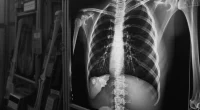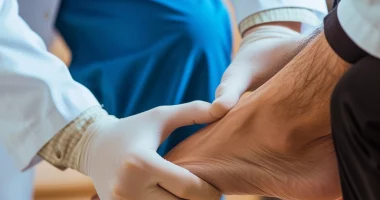Spinal disc herniation
What is a spinal disc herniation?
Spinal disc herniation, or intervertebral herniation, is the most common cause of lower back pain and often requires surgical treatment. Hernias in the lumbosacral spine are the most common, herniated discs in the cervical spine are much less common, and herniated discs in the thoracic spine are the rarest.
An intervertebral disc is a cartilage between two vertebrae, acting as a cushioning pad. The discs keep the vertebrae from touching each other when you move.
The intervertebral disc has an inner part (nucleus pulposus) and an outer part (annulus fibrosus). Under the influence of trauma, heavy physical exertion, or with age, the fibrous ring cracks and loses its density. Part of the pulp core emerges into the cracks, gradually widening them. When the cracks reach a critical size, the outer ring ruptures, and most of the gelatinous (pulp) nucleus emerges. A less severe condition, a protrusion of the nucleus without rupture of the annulus fibrosus, is called a protrusion.
As a rule, the mere fact of a herniated disc does not lead to complaints. The herniation begins to manifest itself when the nerve structures of the spinal canal are compressed – there is numbness, pain, and/or weakness in the limb. That is why most people do not suspect that they have a herniated disc or have no complaints until a certain point.
At the same time, the body tries to stabilize the situation, and osteophytes (bony growths consisting of calcium salts) form along the edge of the vertebrae. Clinical manifestations intensify, and the patient may lose the ability to work.
Over time, the fragments of the pulp ring that have come out spontaneously resorb. Osteophytes increase in size, creating an immobile connection between two neighboring vertebrae. A person stops feeling pain. However, the spinal column completely loses mobility. The average time required for the pain syndrome to subside is 12 months.
Symptoms of intervertebral hernia
The disease occurs more often in people between 25 and 50 years of age whose work is associated with heavy lifting or constant sitting. Clinical manifestations of the disease depend on the area of the spine where the hernia (protrusion) has formed. In the beginning, there is usually numbness in one or another part of the limb, and then a constant burning pain joins. At later stages, there is weakness in the muscles and impaired function of the limb. When a hernia of large size falls out, all the nerve structures of the spinal canal may be compressed, with simultaneous paralysis of the limbs and impaired urinary function. This situation is an emergency and requires the fastest possible (no later than 6 hours from the onset of clinical manifestations) removal of the hernia to free the nerves from compression.
Symptoms of cervicothoracic herniation:
- Intense pain in the neck or chest, resembling in symptomatology even myocardial infarction;
- constant headache accompanied by dizziness;
- fluctuations in blood pressure;
- numbness of the hands or individual fingers decreases reflexes and muscle strength.
Symptoms of lumbosacral hernias:
- severe lumbar pain radiating to the buttocks and legs;
- sudden pain after sudden movement, especially turning the body;
- numbness spreading to the groin, front or back of the thigh, and toes of the foot;
- various disorders of the genitourinary organs – erectile dysfunction, urination, and defecation.
Causes of intervertebral hernia
The exact and unambiguous cause of the formation of intervertebral hernias still needs to be established; discussions on this topic continue.
Scientists believe that the hereditary genetic factor is of the most significant importance. Studies have been published that have shown that degeneration (reverse development, destruction) in people with problematic heredity occurs much earlier than in healthy people. Scientists are no less interested in biomechanical loads: lifting heavy weights, especially in conjunction with torsion (torsional), and prolonged driving and vibration.
Back injuries, traumatic falls, incorrect posture, curvature of the spinal column, and osteochondrosis are bad for the spine. The provoking factor is also called overweight, prolonged sedentary work, and disorders of phosphorus-calcium metabolism in the human body, particularly a lack of vitamin D.
Diagnosis of spinal disc herniation
Magnetic resonance imaging (MRI) is currently the primary method of diagnosing intervertebral hernias. The images perfectly show all the size and condition of the parts of the spinal column and places of degeneration and pathological formations. The same informativeness has another study – computed tomography (CT). After a medical examination, these studies are referred to a neurologist, analyzing the patient’s complaints and clinical picture.
If a protrusion inside the spinal canal is suspected, an X-ray contrast study of the spine pathways conducting the liquor (cerebrospinal fluid) – myelography – is performed.
Laboratory diagnostic methods should be addressed. Blood studies will help identify systemic inflammation, autoimmune diseases, possible nerve damage against the background of infectious viral processes, diabetes mellitus, etc.
Only a combination of all the above research methods gives a complete picture of the disease, allowing you to establish a diagnosis and determine the correct treatment tactics.
Conservative treatment of intervertebral hernia
The main methods of conservative treatment of intervertebral hernia are:
- taking non-steroidal anti-inflammatory drugs;
- chondroprotective medication – remedies for cartilage repair;
- drug blockades;
- physical therapy;
- therapeutic traction on an orthopedic table or in a pool.
Lifestyle modification consisting of steps such as these is of great importance:
- normalization of body weight;
- job change;
- training in proper weight bearing;
- avoidance of sudden movements, jerks, and jumps;
- sleeping on a semi-rigid orthopedic mattress;
- alternating between physical exertion and relaxation;
- systematic physical therapy at home.
The disease progresses most favorably in those patients who accept the limitations and necessary actions caused by the medical condition.
Surgical treatment of spinal disc herniation
If conservative treatment is ineffective (more than three weeks of treatment with no visible result), and in order to achieve recovery in the shortest possible time, surgical treatment methods are used. In addition, absolute indications for surgery are paralysis of the limbs, pelvic organ dysfunction, and urination.
Depending on the clinical situation, the methods used are:
- Microdiscectomy – microsurgical removal of a herniated disc through skin access up to 4 cm long;
- Cold plasma nucleoplasty (herniated discs up to 5-6 mm, protrusions) is a minimally invasive procedure performed through a puncture in the area of the affected disc with a needle (diameter 2-3 mm).
- DISC FX (hernias up to 5-6 mm, protrusions) – the newest procedure combining three techniques at once and increasing efficiency (up to 80%).
- Endoscopic method – using microsurgical instruments and a built-in video camera.
All these surgical treatment options are available in more than 800 hospitals around the world (https://doctor.global/results/diseases/spinal-disc-herniation). For example, microdiscectomy is done in 18 clinics across Turkey for an approximate price of $6.6 K (https://doctor.global/results/asia/turkey/all-cities/all-specializations/procedures/microdiscectomy).
Conclusion
Spinal disc herniation, a prevalent and often painful condition, occurs when the soft cushion between the spinal vertebrae protrudes out of its normal boundary. It’s a condition that not only affects the physical health of individuals but can also significantly impact their quality of life. However, with advancements in medical science, there are now multiple effective treatment options available, ranging from conservative management like physical therapy and medication to surgical interventions for more severe cases. Understanding the causes, symptoms, and treatment options is crucial for effective management. It’s imperative for individuals experiencing back pain or symptoms suggestive of disc herniation to consult healthcare professionals for an accurate diagnosis and tailored treatment plan. Early intervention and adherence to prescribed treatment regimens can greatly improve outcomes and help individuals return to their daily activities with reduced pain and discomfort.


